SIU Director’s Report - Case # 17-PVI-232
Warning:
This page contains graphic content that can shock, offend and upset.
Contents:
Mandate of the SIU
The Special Investigations Unit is a civilian law enforcement agency that investigates incidents involving police officers where there has been death, serious injury or allegations of sexual assault. The Unit’s jurisdiction covers more than 50 municipal, regional and provincial police services across Ontario.
Under the Police Services Act, the Director of the SIU must determine based on the evidence gathered in an investigation whether an officer has committed a criminal offence in connection with the incident under investigation. If, after an investigation, there are reasonable grounds to believe that an offence was committed, the Director has the authority to lay a criminal charge against the officer. Alternatively, in all cases where no reasonable grounds exist, the Director does not lay criminal charges but files a report with the Attorney General communicating the results of an investigation.
Information restrictions
Freedom of Information and Protection of Personal Privacy Act (“FIPPAâ€)
Pursuant to section 14 of FIPPA (i.e., law enforcement), certain information may not be included in this report. This information may include, but is not limited to, the following:
- Confidential investigative techniques and procedures used by law enforcement agencies; and
- Information whose release could reasonably be expected to interfere with a law enforcement matter or an investigation undertaken with a view to a law enforcement proceeding.
Pursuant to section 21 of FIPPA (i.e., personal privacy), protected personal information is not included in this document. This information may include, but is not limited to, the following:
- subject officer name(s)
- witness officer name(s)
- civilian witness name(s)
- location information
- witness statements and evidence gathered in the course of the investigation provided to the SIU in confidence and
- other identifiers which are likely to reveal personal information about individuals involved in the investigation
Personal Health Information Protection Act, 2004 (“PHIPAâ€)
Pursuant to PHIPA, any information related to the personal health of identifiable individuals is not included.
Other proceedings, processes, and investigations
Information may have also been excluded from this report because its release could undermine the integrity of other proceedings involving the same incident, such as criminal proceedings, coroner’s inquests, other public proceedings and/or other law enforcement investigations.
Mandate engaged
The Unit’s investigative jurisdiction is limited to those incidents where there is a serious injury (including sexual assault allegations) or death in cases involving the police.
“Serious injuries†shall include those that are likely to interfere with the health or comfort of the victim and are more than merely transient or trifling in nature and will include serious injury resulting from sexual assault. “Serious Injury†shall initially be presumed when the victim is admitted to hospital, suffers a fracture to a limb, rib or vertebrae or to the skull, suffers burns to a major portion of the body or loses any portion of the body or suffers loss of vision or hearing, or alleges sexual assault. Where a prolonged delay is likely before the seriousness of the injury can be assessed, the Unit should be notified so that it can monitor the situation and decide on the extent of its involvement.
This report relates to the SIU’s investigation into the serious injury reportedly sustained by a 30-year-old man following a vehicular police pursuit on August 27, 2017.
The investigation
Notification of the SIU
At approximately 1:30 a.m. on August 27, 2017, the Rideau Lakes Detachment of the Ontario Provincial Police (OPP) notified the SIU of the serious injuries sustained by the 30-year-old Complainant subsequent to a single vehicle rollover collision during a Suspect Apprehension Pursuit (SAP).
The OPP reported that just after midnight on August 27, 2017, OPP officers, in conjunction with members of the Smiths Falls Police Service (SFPS), responded to a 911 unknown trouble call at an address at which the 911 caller lived in the Township of Rideau Lakes. The caller, a woman, was heard crying on the telephone before the dispatcher lost contact with her.
As the police officers arrived at the address, a pickup truck sped from the residence at a high rate of speed. The police officers initiated a brief pursuit of the vehicle but soon abandoned the pursuit and returned to the road on which the 911 caller lived. A short time later, the same pickup truck returned to the scene and a second pursuit was started but again aborted due to safety concerns.
In the area of Highway 15 and the road on which the 911 caller lived, the pickup truck deliberately collided with two SFPS police cruisers and the chase was on again. The police officers could not catch up to the fleeing suspect but shortly thereafter found the truck on its side in the bush on the west side of Highway 15. The Complainant suffered quite serious injuries having been ejected from the vehicle.
The Team
Number of SIU Investigators assigned: 4
Number of SIU Forensic Investigators assigned: 2
Number of SIU Collision Reconstructionist assigned: 1
On August 27, 2017, the SIU initiated an investigation in Rideau Lakes. Civilian Witnesses (CWs) were identified and interviewed and medical reports were obtained from the Complainant on consent, notwithstanding the fact that he declined an interview. The scene was measured, photographed and a diagram was prepared. An SIU collision reconstructionist completed a comprehensive report on the technical aspects of the various collisions.
Complainant:
30-year-old male declined to be interviewed, medical records obtained and reviewed
Civilian Witnesses
CWÂ #1 Interviewed
Witness Officers
WOÂ #1 Interviewed, notes received and reviewed
WOÂ #2 Interviewed, notes received and reviewed
WOÂ #3 Interviewed, notes received and reviewed
Subject Officers
SOÂ #1 Interviewed, notes received and reviewed
Incident narrative
On August 27, 2017, at approximately 10:30 p.m., members of the SFPS and the Rideau Lakes OPP responded to an unknown trouble call at a residence on the road on which the 911 caller lived in the Township of Rideau Lakes. The call involved a female caller who lost contact with the dispatcher. The caller was crying. As the police officers arrived at the road on which the 911 caller lived, a pickup truck known to be connected to the residence left the scene while narrowly avoiding contact with the police cruisers. The truck was driven by the Complainant.
During the course of attempting to apprehend the Complainant, three vehicular police pursuits were initiated, with each being terminated shortly after being initiated, for safety reasons. On each occasion, when the decision was made to terminate the vehicular pursuit and the police vehicles pulled over to the shoulder and stopped, the Complainant would return to the location of the police vehicles driving at high rates of speed and dangerously, apparently taunting the police to initiate another pursuit.
Three SFPS cruisers and one OPP marked SUV were involved in the pursuits. All SFPS cruisers were equipped with in-car camera cystems (ICCS) but the sole OPP vehicle, driven by the Subject Officer (SO), was not. During the incident, two of the SFPS cruisers, driven by Witness Officer (WO)Â #3 and WOÂ #2, were damaged through contact with the pickup truck operated by the Complainant and were rendered inoperable. The OPP vehicle operated by the SO and the SFPS cruiser operated by WOÂ #1 were driven in tandem as they followed and pursued the Complainant, allowing the SFPS cruiser to record the entire incident.
The second pursuit involved an incident on the road on which the 911 caller lived in which WO #3 tried to stop the Complainant from re-entering Highway 15. WO #3’s air bags deployed upon making contact with the truck, effectively ending his involvement. WO #2’s cruiser also sustained substantial damage but was able to lead the pursuit of the Complainant, who managed to escape capture and enter northbound Highway 15.
WO #2 was followed by WO #1 and the SO. WO #2’s cruiser finally broke down and he was forced to pull over to the shoulder. WO #1 then pulled up beside WO #2 to see if he was okay, slowing his vehicle in doing so, and thereby losing sight of the pickup truck.
The ICC camera evidence obtained from WO #1’s cruiser captured not only the entire event, but in particular, the final moments of the third pursuit which ended with the rollover collision that seriously injured the Complainant.
The video reveals that once the Complainant was out of view, WOÂ #1 and the SO continued northbound, never regaining sight of the pickup truck until they came upon a collision scene wherein the pickup truck had rolled over and entered the ditch.
Nature of Injuries / Treatment
The Complainant was examined and found to have sustained a fracture to the right inferior pubic bone and a medial fracture to the left ankle. He also received ten sutures to close a wound to the back of his head.
Evidence
The Scene
There are two collision scenes in relation to this incident. The initial scene is on the road on which the 911 caller lived, just east of Highway 15. No one was injured during the collisions at that scene.
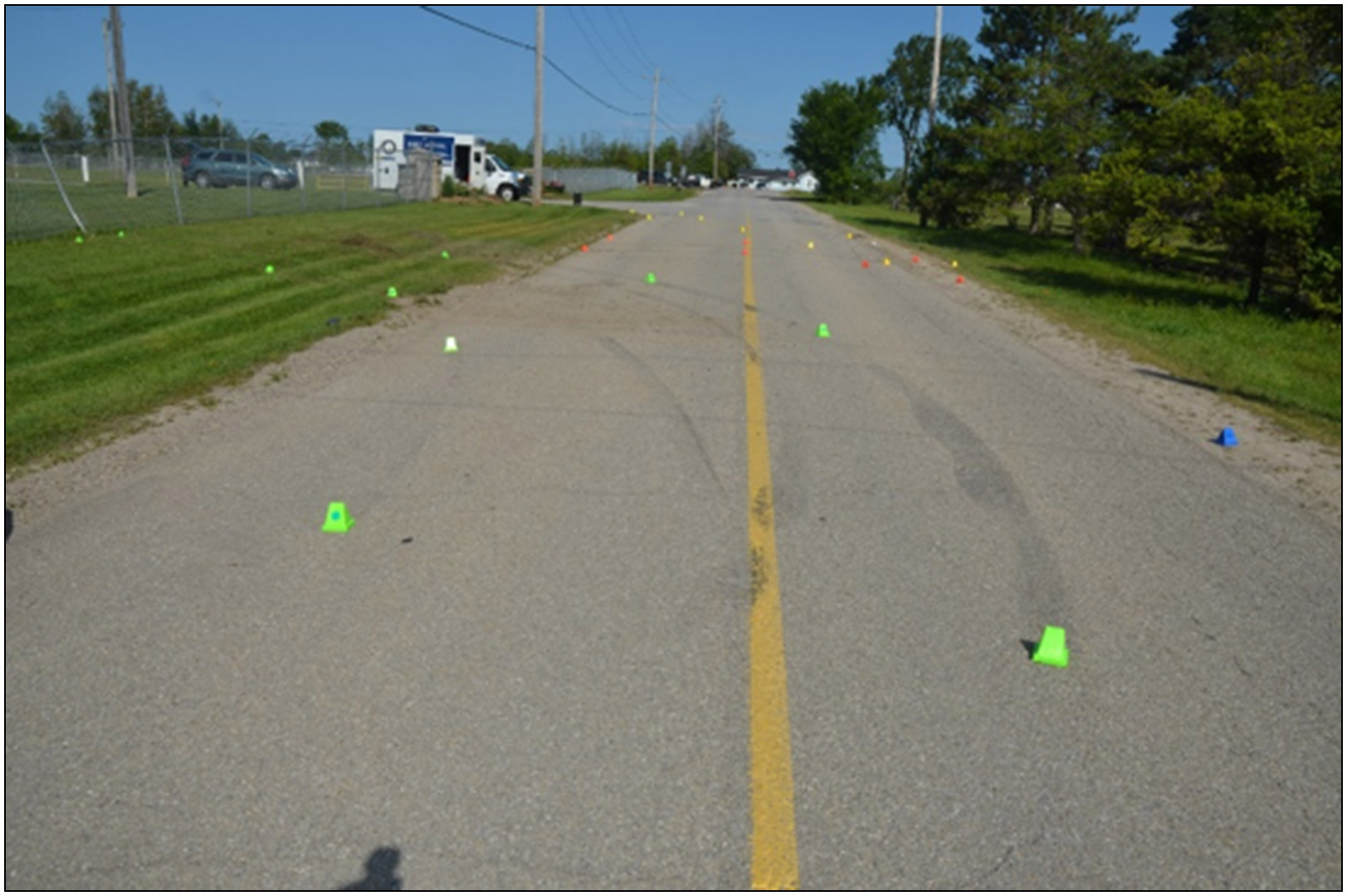
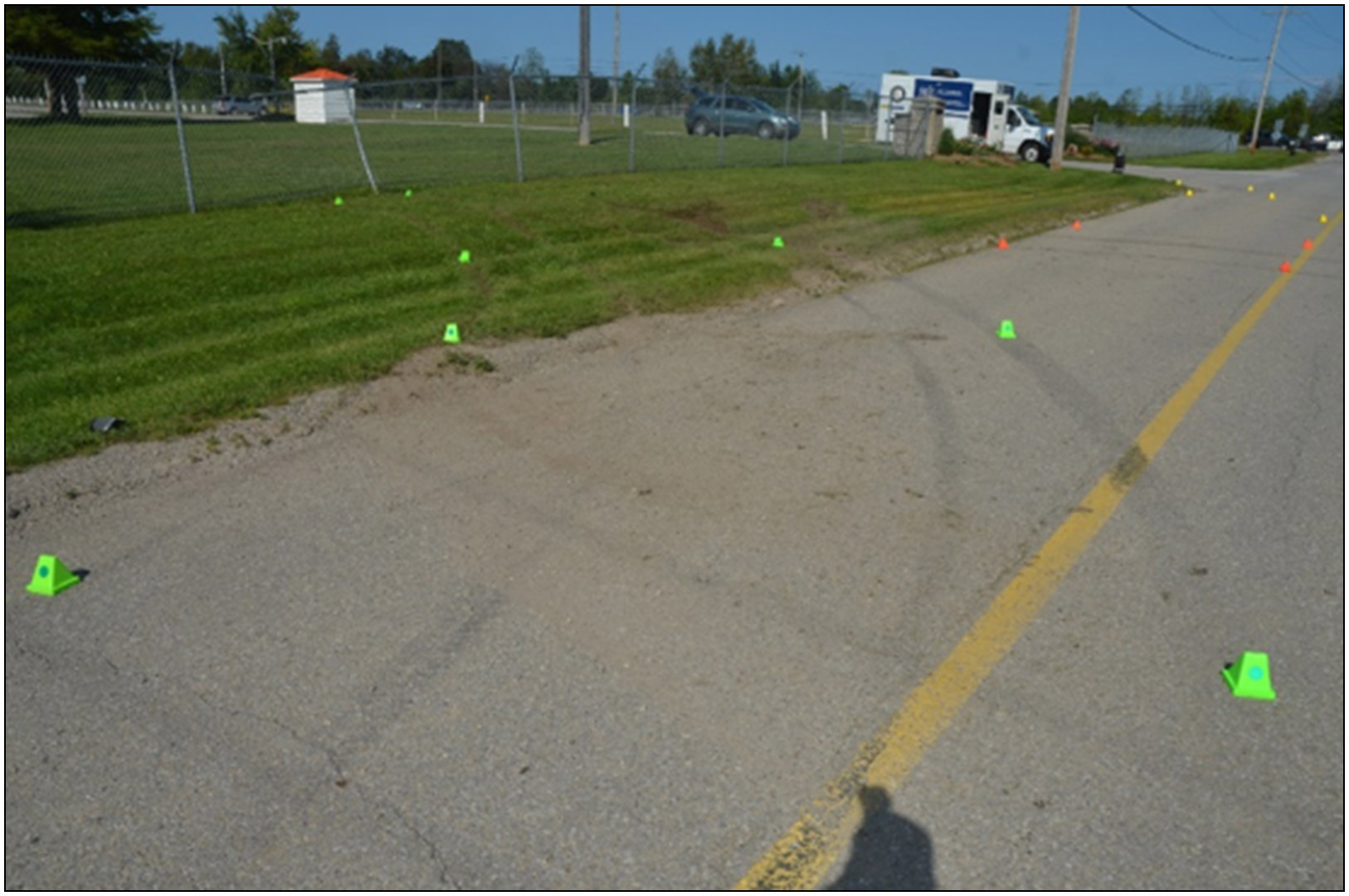
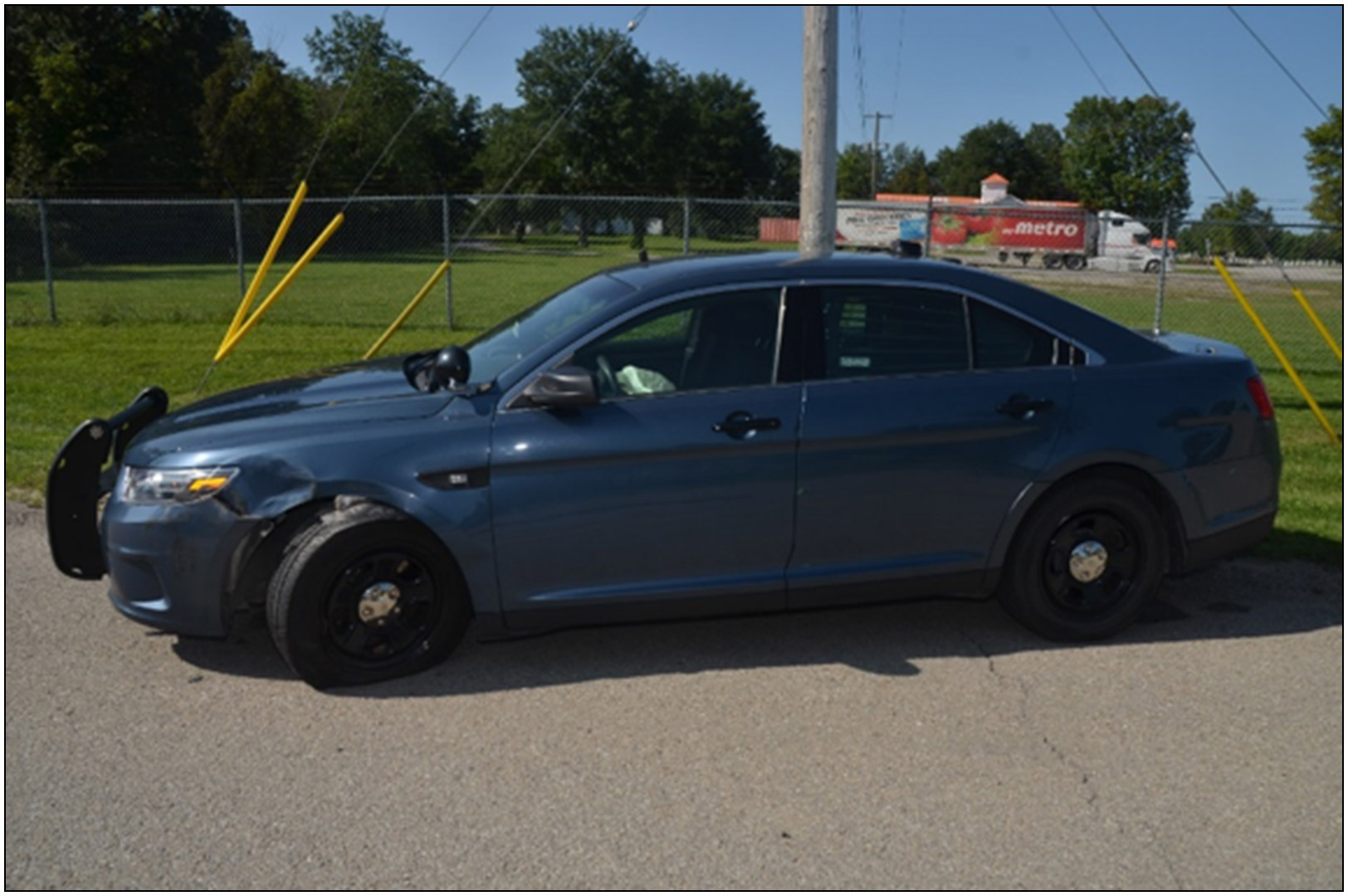
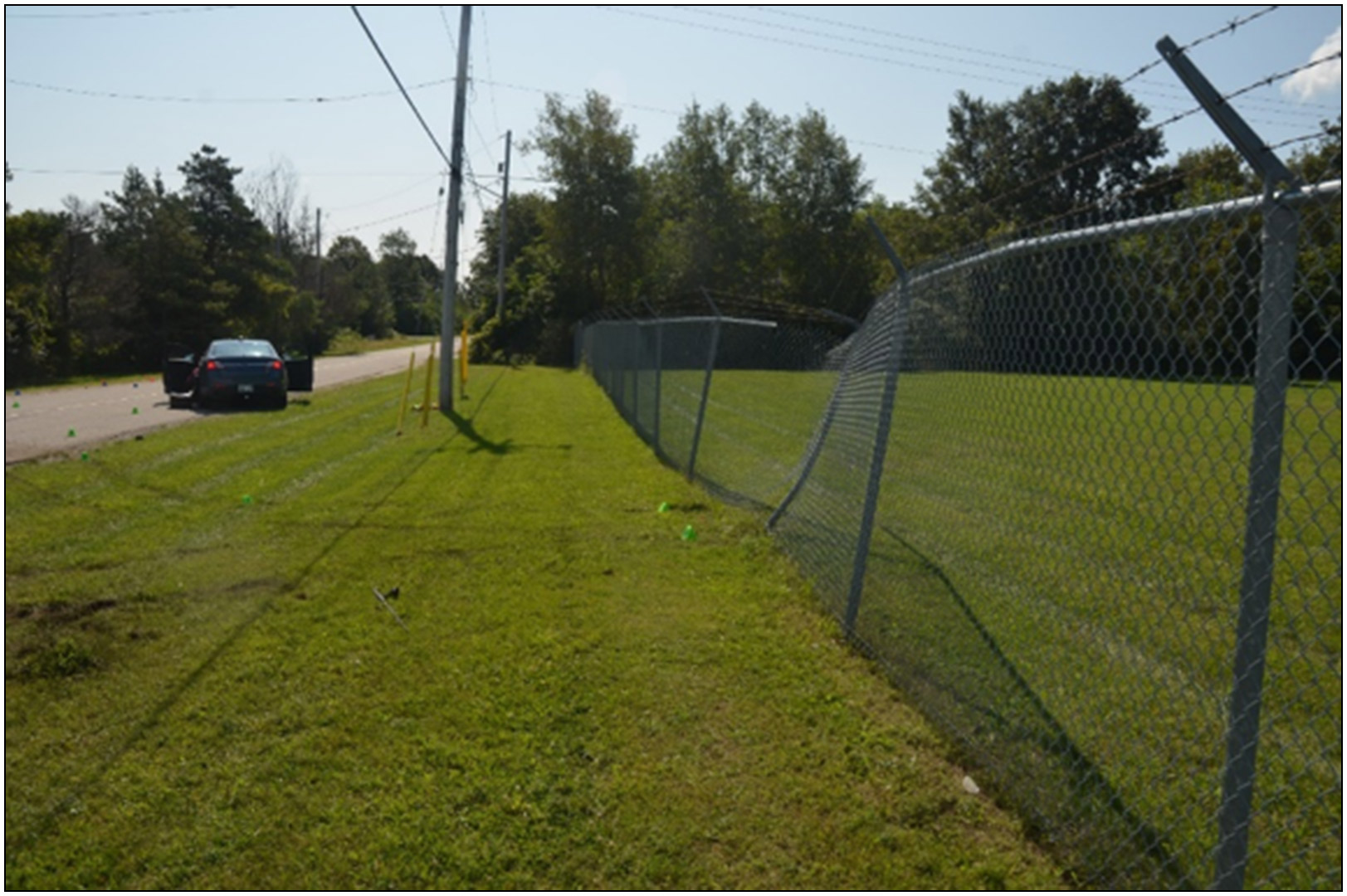
The second scene (depicted in the diagram below) is on Highway 15 near the quarry of Campbell’s Trucking Company, just south of the Town of Smiths Falls. The distance between the two collision scenes is 3.27 kilometres.
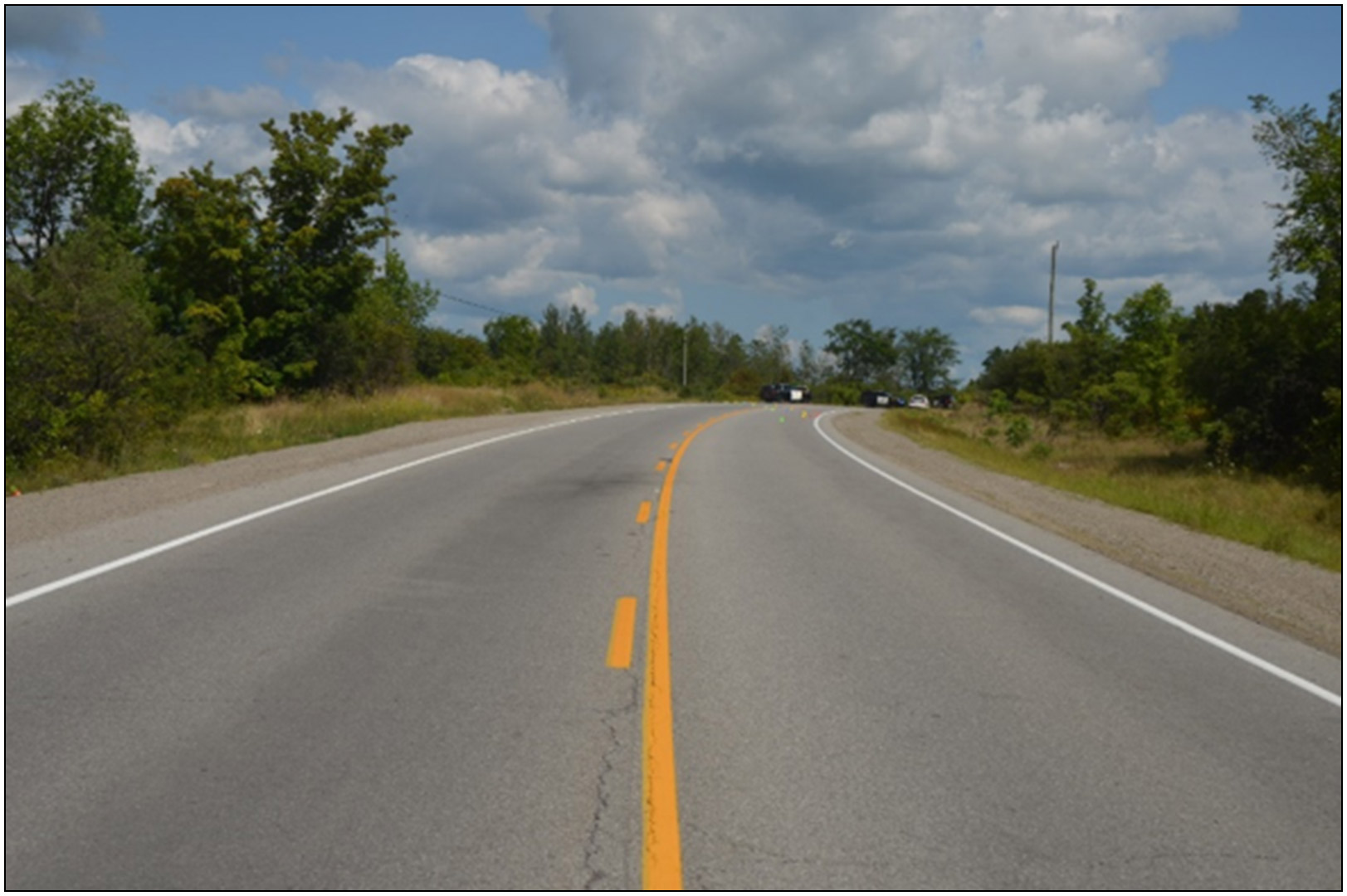
In the area of the rollover collision that caused the injuries to the Complainant, Highway 15 is a two lane paved asphalt roadway that permits one lane of northbound and one lane of southbound vehicular movement. At the centre of the road, a solid double yellow paint mark delineates the opposing lanes. Solid white painted fog lines and deep ditches line the edges of the road. There is no artificial lighting in the area.
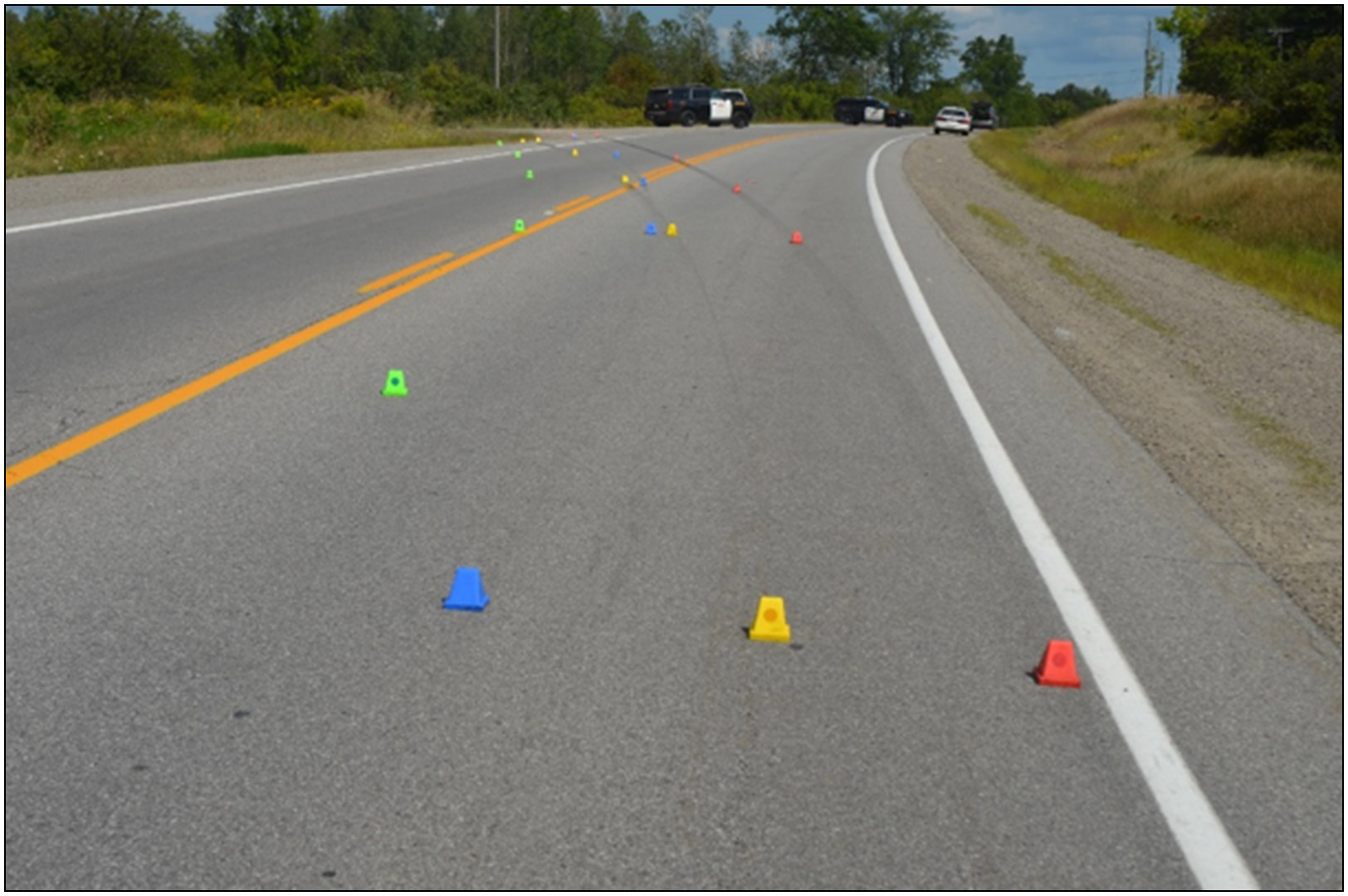
In the area of the collision, there is a long right hand curve for northbound traffic with a slight ascending grade. A gravel quarry is situated on the west side of Highway 15 near the collision scene with a construction sign, “Campbell’s Trucking Company,†posted at the entrance. The roadway running west from Highway 15 and into the quarry is loose gravel. The sight lines are good and the posted speed limit is 80 km/h.
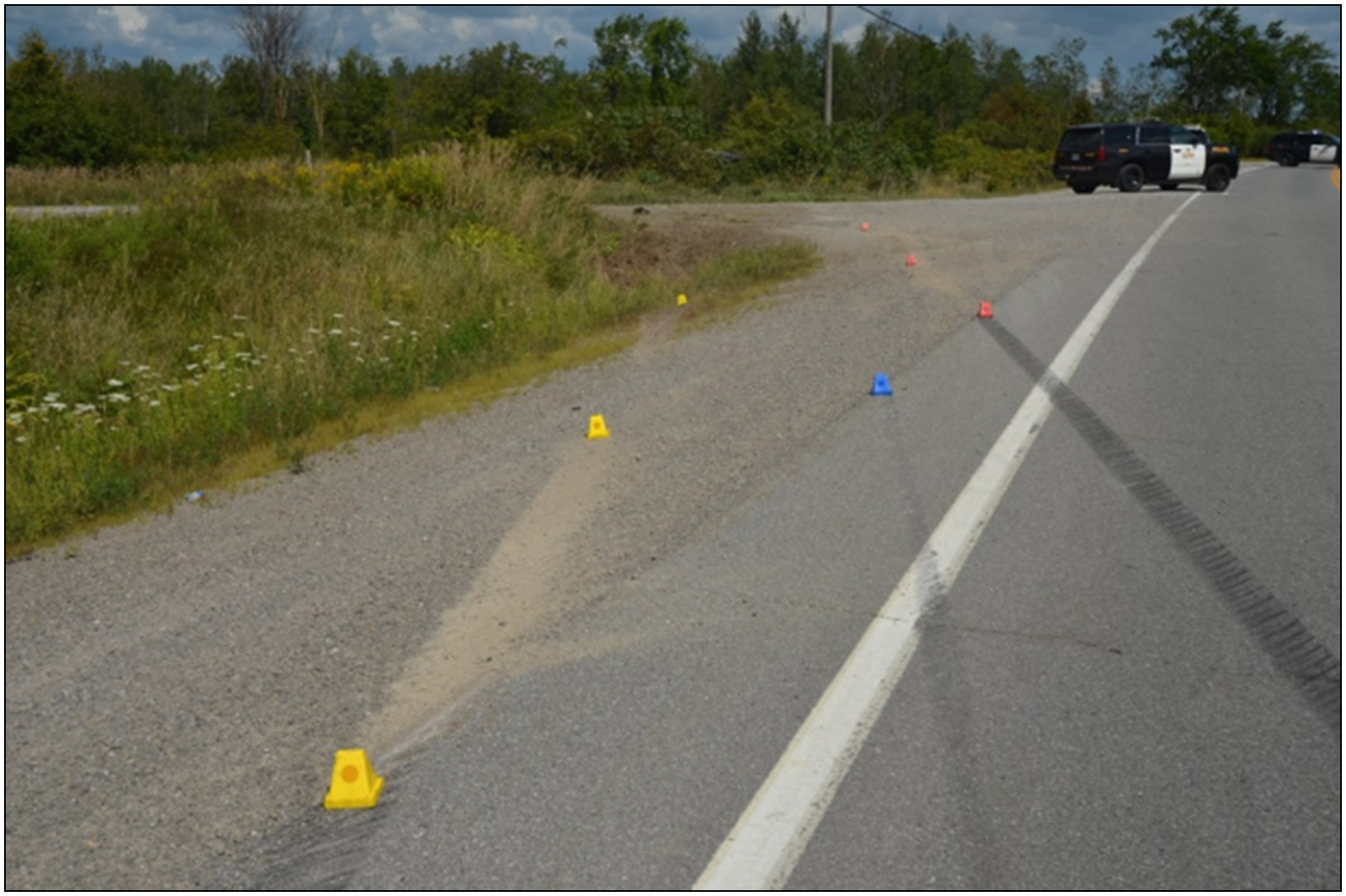
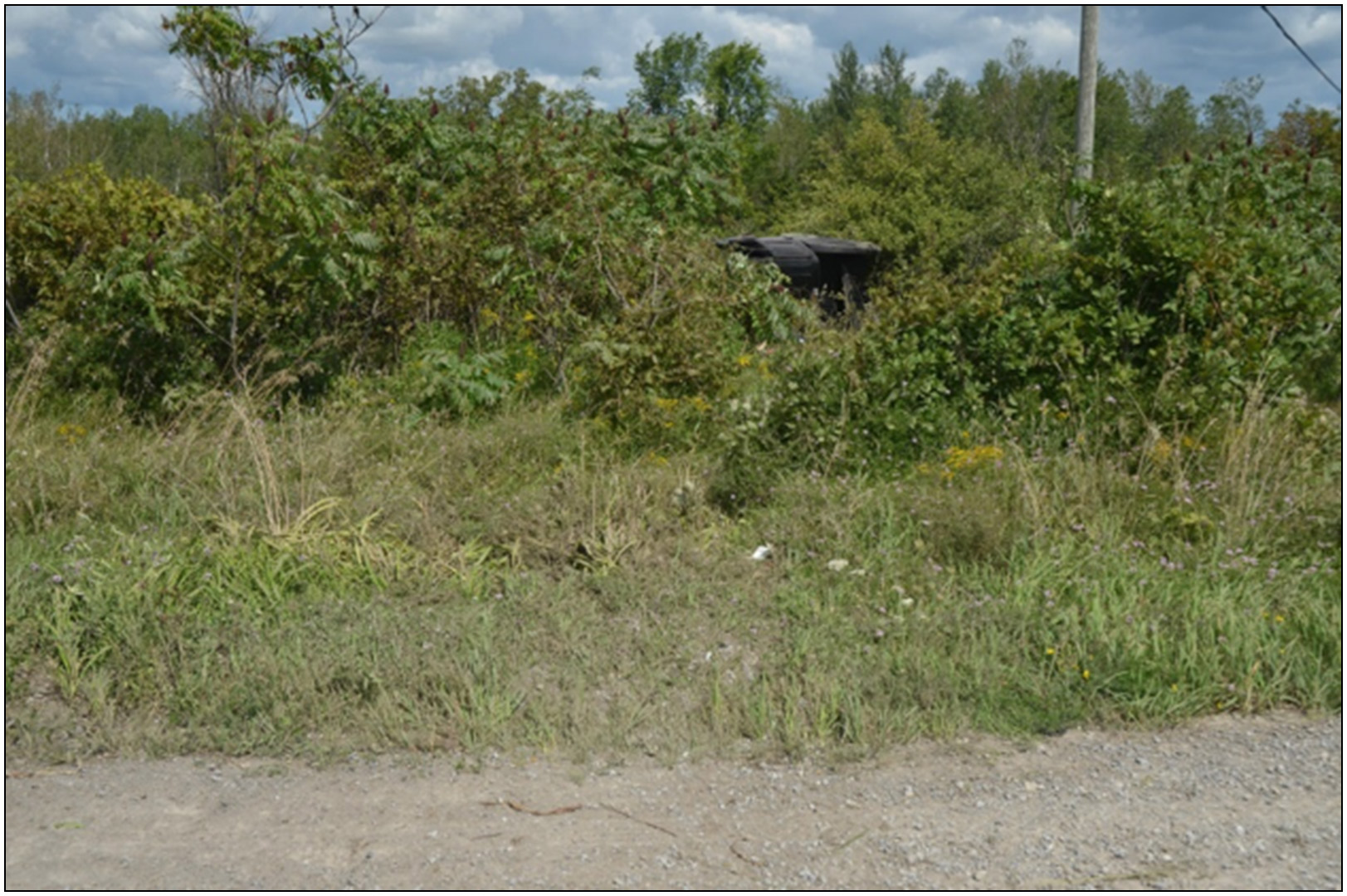
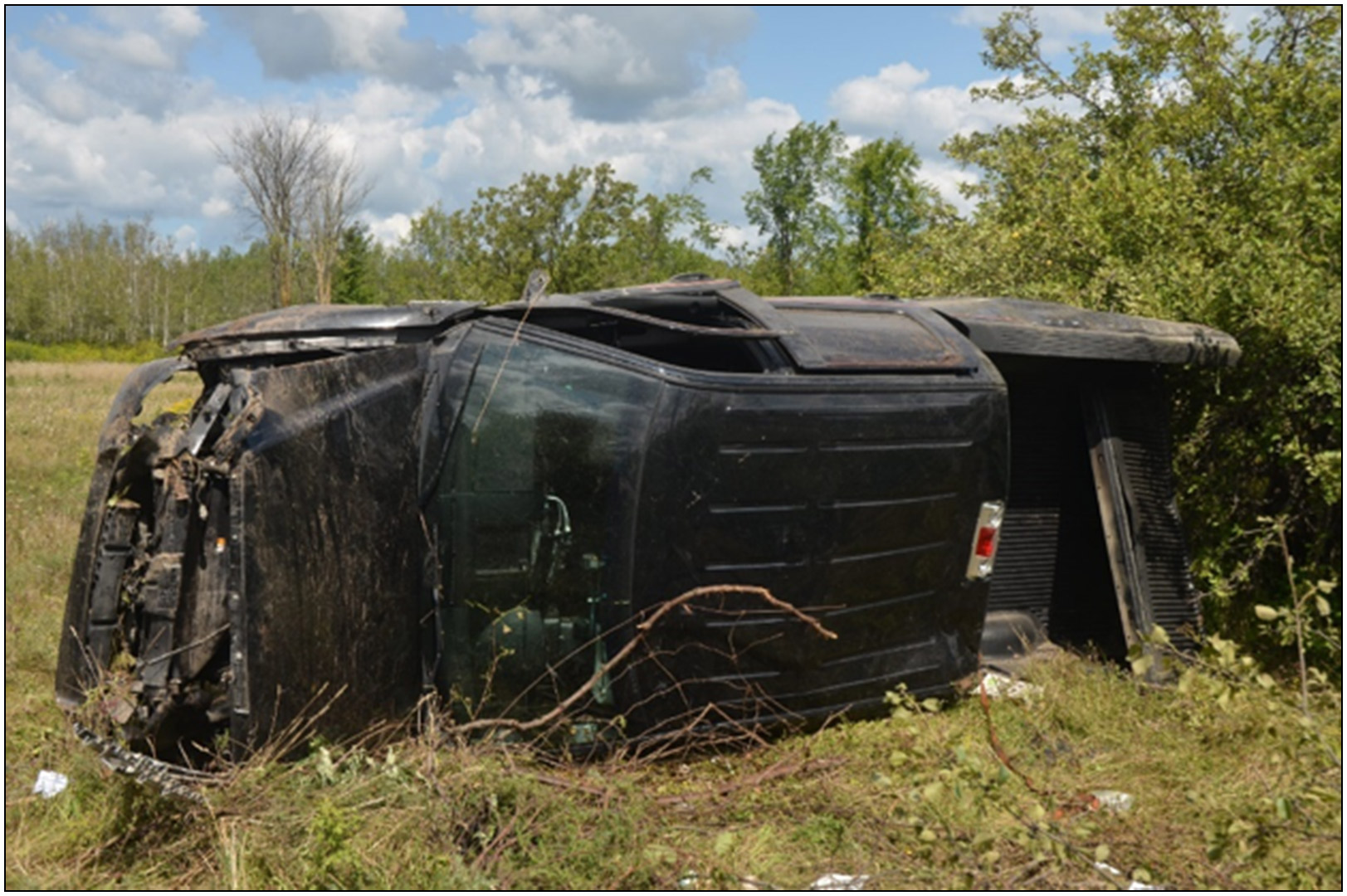
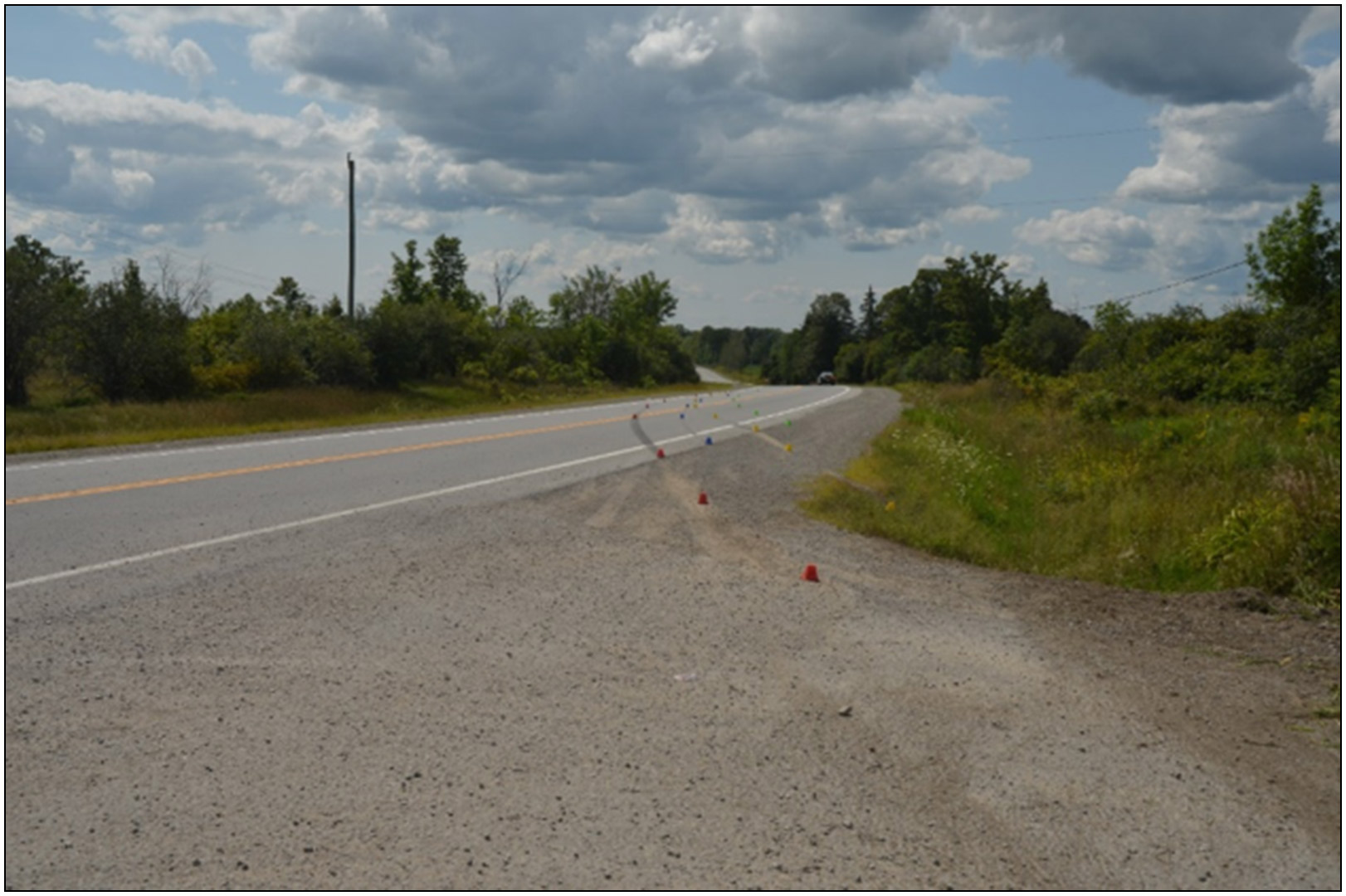
Scene Diagram
Initial Collision Scene
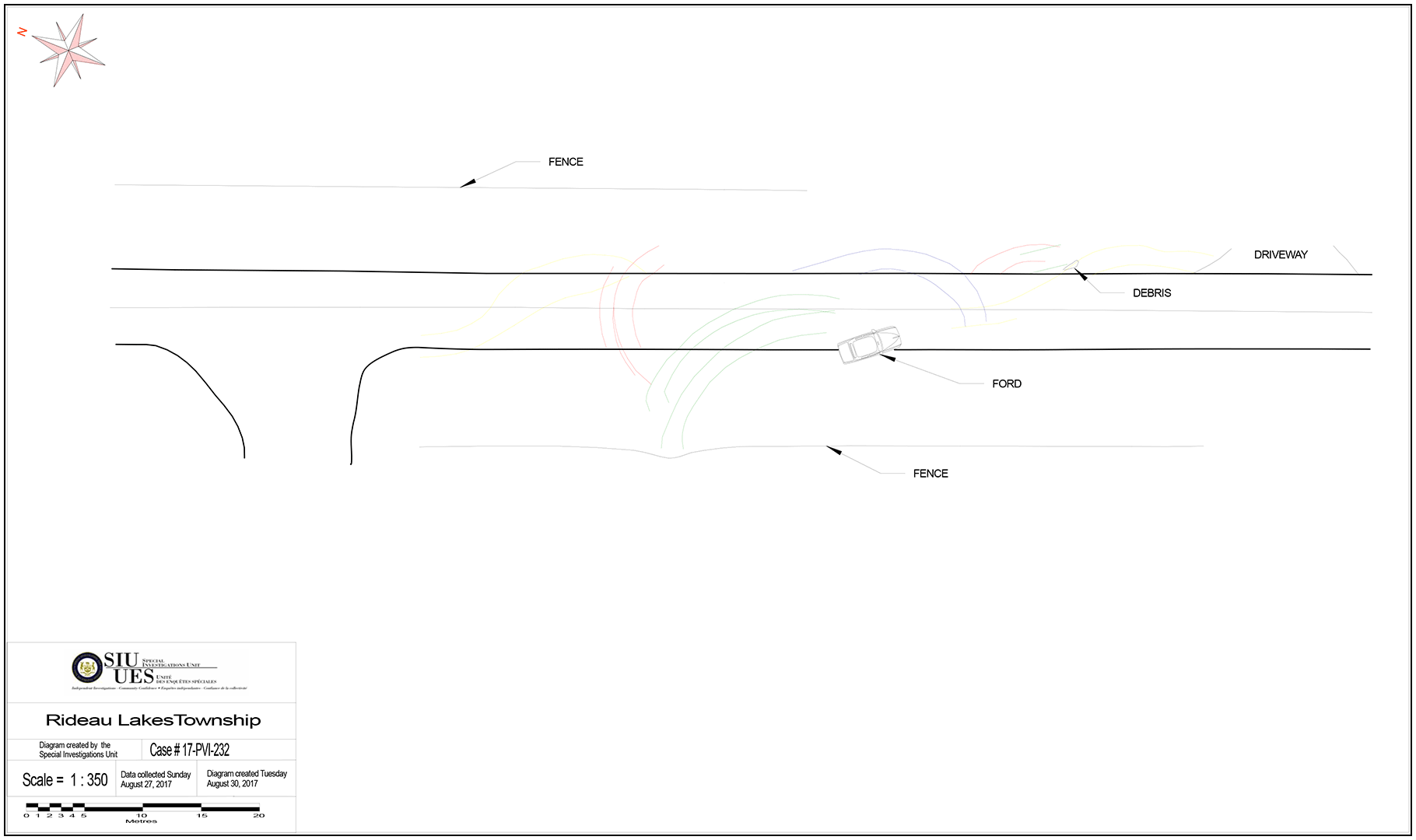
Terminating Collision Scene on Highway 15
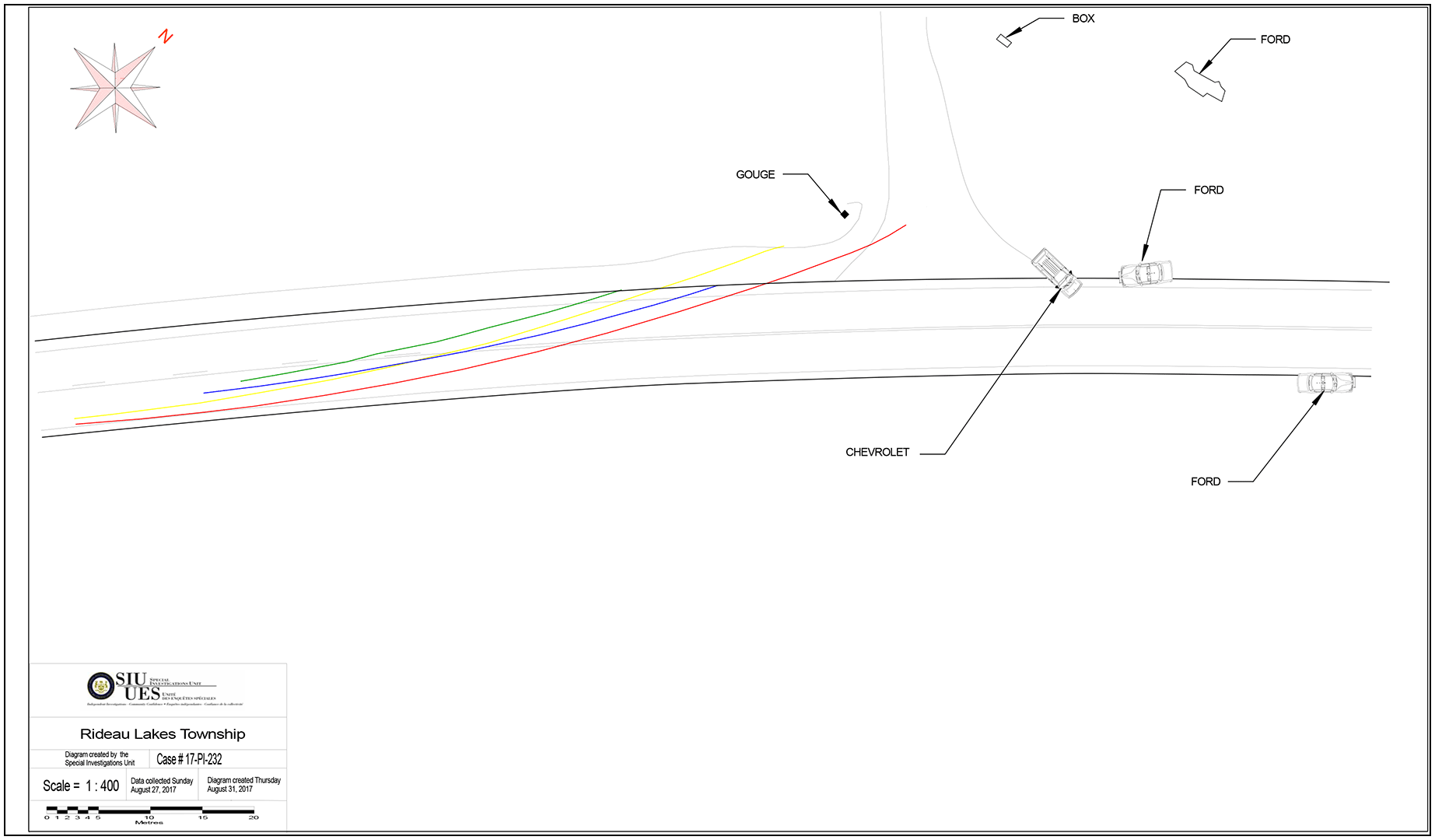
Forensic Evidence
No submissions were made to the Centre of Forensic Sciences.
Video/Audio/Photographic Evidence
Analysis of the In-Car Camera (ICC) Data
Although the three SFPS cruisers were equipped with ICC equipment, it was only WO #1’s cruiser that captured the final moments of the pursuit. WO #3’s cruiser was rendered inoperable at the road on which the 911 caller lived scene and the cruiser operated by WO #2 sputtered out on Highway 15, some distance south of the final impact scene. WO #1 was at all times throughout the incident driving in tandem with the subject OPP officer whose cruiser had no ICC equipment. The following is a summary of the ICC video from WO #1’s police cruiser.
ICC of WOÂ #1
On August 26, 2017, at 10:43 p.m., WO #1 travelled on a roadway in the residential area in the Town of Smiths Falls. The SO was operating an OPP SUV fully marked police vehicle and was travelling ahead of WO #1. Both police vehicles had their emergency lighting activated.
WOÂ #1 followed the SO from Smiths Falls southbound on Highway 15. The speeds from both police vehicles averaged between 150 to 160Â km/h on southbound Highway 15.
At 10:46 p.m., just south of Golf Club Road, the emergency lighting on both police vehicles was deactivated. WO #1 turned left from southbound Highway 15 onto the road on which the 911 caller lived and traveled eastbound behind the SO’s police vehicle.
Just east of the entrance to the Lombardy Agricultural Society Fairgrounds, the SO’s police vehicle slowed down almost to a stop and steered to the left, straddling the centre yellow painted line while applying his brakes. A dark coloured pickup truck is seen travelling towards the SO’s police vehicle. The pickup truck was travelling in the westbound lane of the road on which the 911 caller lived partially driving on the gravel shoulder of the roadway. The pickup truck passed by the driver’s side of the SO’s police vehicle, almost colliding with the left side, and then continued forward and passed by the driver’s side of WO #1’s police vehicle.
WOÂ #1 reversed his police vehicle to the right, traveled forward while turning to the left, and then travelled westbound on the road on which the 911 caller lived in the direction of the pickup truck. WOÂ #1 activated the overhead emergency lighting of his police vehicle. The pickup truck approached the stop sign at the road on which the 911 caller lived and Highway 15, failed to stop for the stop sign, and turned right heading northbound on Highway 15.
The pickup truck then made a wide right turn, almost colliding with a vehicle driving southbound in the left turn lane of Highway 15 at the road on which the 911 caller lived. WO #1 then accelerated behind the pickup truck, with his emergency lighting and siren activated. The distance between the pickup truck and WO #1’s police vehicle appears to be about four to five vehicle lengths and the speed from the recorded police vehicle GPS is 130 km/h.
The pickup truck entered a left hand curve and the right side tires of the pickup truck travelled over the white fog line onto the gravel shoulder of the roadway. The pickup truck straightened out and then traveled to the left, across the yellow painted centre line approaching Golf Club Road. The distance between the pickup truck and WO #1’s police vehicle was increasing at that point.
The pickup truck then approached a left hand curve in the roadway, and the distance between the pickup truck and WO #1’s police vehicle increased further. The GPS indicated the speed of WO #1’s police vehicle was 145 km/h at that point.
The pickup truck traveled northbound past the Rideau Lakes OPP Detachment and passed two vehicles ahead by driving left of the solid double yellow line into the southbound lane of Highway 15. The two civilian vehicles pulled to the right side of the roadway onto the gravel shoulder as WO #1 approached them. WO #1’s police vehicle then slowed to less than 80 km/h while he passed one of the civilian vehicles and then pulled in behind the lead civilian vehicle.
At 10:49 p.m., WO #1 deactivated his emergency lighting and pulled his police vehicle to the right side of the roadway onto the gravel shoulder and came to a stop. WO #1 can be heard on the audio stating his police vehicle number and odometer reading. The SO’s police vehicle is then seen to pass WO #1’s cruiser on the left and continue ahead northbound on Highway 15. The emergency lighting was seen not to be activated on the SO’s police vehicle. The SO’s police vehicle approached a civilian vehicle traveling northbound on Highway 15 and his emergency lighting was then activated.
The civilian vehicle pulled to the right side of the roadway onto the gravel shoulder and WO #1 traveled forward from the gravel shoulder back onto the paved roadway and continued northbound. After the SO’s police vehicle passed the civilian vehicle, he again deactivated the emergency lighting system. WO #1 remained behind the civilian vehicle traveling at an average speed of 75 km/h.
At 10:50 p.m., WO #1 approached Progress Road. Just south of the T-intersection, the SO’s police vehicle can be seen stopped on the right gravel shoulder of the roadway. Progress Road runs in an east direction from Highway 15. WO #1 pulled his police vehicle alongside the driver’s side of the SO’s police vehicle and stopped facing the same direction.
The SO and WOÂ #1 are then heard on the audio stating that they are going back to the residence on the road on which the 911 caller lived to check on the status of the female who had initially called 911. A pickup truck can be seen a short distance ahead, pulling out from Progress Road and turning left to head southbound on Highway 15 towards the location of the two stopped police vehicles. The pickup truck made a wide left hand turn going onto the west side gravel shoulder and then travelled southbound past both police vehicles, with its right side tires over the white fog line, towards the gravel shoulder of the southbound lane.
WOÂ #1 can be heard asking the SO if the approaching pickup truck was their suspect, before confirming immediately thereafter that it was. WOÂ #1 then made a U-turn and travelled southbound on Highway 15 while the pickup truck passed by on his left side. At 10:51Â p.m., WOÂ #1 activated the emergency lighting on his police vehicle and pulled to the right onto the gravel shoulder of the roadway to allow the SO to pass by his police vehicle on the left side.
The SO then passed WO #1’s cruiser while activating the emergency lighting on his police vehicle. WO #1 pulled his police vehicle back onto the roadway and followed the SO’s police vehicle southbound on Highway 15. The pickup truck was no longer in sight at that point. Just north of the OPP Rideau Lakes Detachment, the emergency lighting was deactivated on both the SO’s and WO #1’s police vehicles.
At 10:52 p.m., just north of Golf Club Road, the SO’s police vehicle moved from the paved roadway onto the right hand gravel shoulder of the roadway and stopped. WO #1 again pulled his police vehicle up alongside the driver’s side of the SO’s cruiser and stopped, facing in the same direction.
The SO is heard on the video giving his odometer reading and location to the dispatcher. He is then heard to tell WOÂ #1 that they will not permit him to pursue further. WOÂ #1 is then heard telling the SO that they had to get to the house on the road on which the 911 caller lived to ensure the female caller was okay and that he had to do the same.
At 10:53 p.m., the SO’s cruiser pulled left back onto the roadway and traveled southbound on Highway 15 with WO #1 directly behind. The emergency lighting systems on both police vehicles were inactive. The SO and WO #1 then turned left onto the road on which the 911 caller lived from Highway 15 and went eastbound at 40 km/h. A vehicle was then observed approaching with its front headlights illuminated.
The emergency lighting systems on both police cruisers are then seen to be re-activated, following which the SO’s police vehicle slowly moved to the left, straddling the centre line, and stopped. WO #1 also steered his police vehicle to the left, entering into the westbound lane of the road on which the 911 caller lived, to the left of, and just slightly behind, the SO’s cruiser. The oncoming vehicle, the pickup truck, then steered to the right, first onto the gravel shoulder and then onto the grassy area, following which he drove past the left side of the two police vehicles. The pickup truck can be seen to be extremely close to WO #1’s cruiser as it passed by. WO #1 is then heard to report that the pickup truck had just collided with one of the SFPS cruisers.
At 10:54 p.m., WO #1 then reversed his police vehicle to the right, and drove forward while steering to the left, to travel westbound on the road on which the 911 caller lived. WO #2’s police vehicle can be seen travelling ahead of WO #1’s police vehicle. The pickup truck can be seen travelling westbound on the road on which the 911 caller lived towards Highway 15, in the eastbound lane of traffic. The emergency lighting was activated on WO #2’s police vehicle.
The pickup truck steered hard to the right, back into the westbound lane in front of WO #2’s cruiser, and then turned right onto Highway 15. The pickup truck did not stop for the stop sign and travelled northbound on Highway 15 from the road on which the 911 caller lived.
WO #2’s cruiser is seen directly behind the pickup truck. WO #1 turned right onto Highway 15 and traveled northbound behind WO #2. The pickup truck and WO #2’s police vehicle were travelling northbound on Highway 15 in the southbound turn lane for the road on which the 911 caller lived. WO #1’s police vehicle then drove over several items of debris strewn on the roadway, believed to be from the pickup truck box, and the damaged aluminum push bar from the front of WO #2’s cruiser.
WO #1’s police vehicle, as recorded by the GPS, was moving at 120 km/h at that point. The pickup truck can be seen to pass Golf Club Road and the distance between the pickup truck and WO #2’s cruiser increased. Just north of Golf Club Road, WO #2’s vehicle quickly slowed and pulled to the right onto the gravel shoulder of the roadway. WO #1 then passed WO #2 on the left and continued travelling northbound on Highway 15.
The pickup truck can no longer be seen on the video at this point, and no rear tail lights are visible ahead. At 10:56Â p.m., just north of the OPP Rideau Lakes Detachment, WOÂ #1 entered a long right hand curve in the roadway and his police vehicle slowed. Thick black tire marks can be seen on the paved asphalt, commencing in the northbound lane, crossing the painted yellow centre line, continuing into the southbound lane, and then onto the west side gravel shoulder into a deep ditch.
A spotlight can be seen originating from WO #1’s police vehicle and shining in the direction of the ditch and the gravel shoulder area on the west side of Highway 15. Headlights are visible in the field area west of the ditch area of the roadway and WO #1’s police vehicle came to a stop on the west side gravel shoulder of the southbound lanes facing in a northbound direction.
Expert Evidence
The Collision Reconstruction Report
The SIU Collision Reconstruction report indicated that the Complainant lost control of the pickup truck that he was driving in a long right hand curve with an ascending grade, causing it to rotate counter-clockwise traveling from the northbound lane across the southbound lane of Highway 15 and into a deep ditch on the west side of Highway 15. The gouge in the ditch was 7.5 metres west of the west edge of the southbound lane of Highway 15 and on the south side of the gravel roadway that runs west from Highway 15.
In examining the tire marks at the scene and analyzing the Power Control Module (PCM) report, it is evident that the Complainant lost control of the pickup truck and entered into the ditch at a high rate of speed. In examining the PCM report, the speed of the pickup truck was a constant 159 to 161 km/h, five seconds prior to “time zero†(the point of impact). The accelerator pedal was fully depressed at 100% and the brake switch was off when the pickup truck lost control, indicating that the Complainant was accelerating at full throttle while in the right hand curve.
The roadway evidence could not assist with determining the pre-impact speed of the pickup truck prior to entering into, and making contact with, the ditch embankment. The pickup truck was accelerating when it lost control and rotated counter-clockwise across the travelled lanes. According to the PCM data, the pickup truck was at a constant speed of 159Â km/h as it entered into the right hand curve, causing the Complainant to lose control of the vehicle.
The final resting location of the pickup truck was measured, however, from the point the pickup truck struck the ditch embankment to the first contact, or touch down, with the ground could not be determined from the scene evidence.
Communications Recordings
The 911 call and the police radio transmission recordings were obtained and reviewed and found to be consistent with the statements provided and with the ICC videos.
Materials obtained from Police Service
Upon request, the SIU obtained and reviewed the following materials and documents from the OPP Rideau Lakes Detachment (Leeds County) and the SFPS
- Arrest Report for the Complainant
- 911 call and Police Transmission Communications Recordings
- Event Chronologies (x2)
- General Occurrence Report
- Involved Persons List
- Motor Vehicle Collision Report
- Notes of WOÂ #s 1-3 and the SO
- The In-Car Video of the three involved SFPS vehicles
- GPS/Automatic Vehicle Locator (AVL) data from the SO’s police vehicle
- OPP Communications CD, and
- OPP Procedure: Suspect Apprehension Pursuits
The SIU obtained and reviewed the following materials and documents from other sources:
- The Complainant’s medical records
Relevant legislation
Sections 1-3, Ontario Regulation 266/10, Ontario Police Services Act – Suspect Apprehension Pursuits
1. (1) For the purposes of this Regulation, a suspect apprehension pursuit occurs when a police officer attempts to direct the driver of a motor vehicle to stop, the driver refuses to obey the officer and the officer pursues in a motor vehicle for the purpose of stopping the fleeing motor vehicle or identifying the fleeing motor vehicle or an individual in the fleeing motor vehicle
(2) A suspect apprehension pursuit is discontinued when police officers are no longer pursuing a fleeing motor vehicle for the purpose of stopping the fleeing motor vehicle or identifying the fleeing motor vehicle or an individual in the fleeing motor vehicle.
2. (1) A police officer may pursue, or continue to pursue, a fleeing motor vehicle that fails to stop
- if the police officer has reason to believe that a criminal offence has been committed or is about to be committed; or
- for the purposes of motor vehicle identification or the identification of an individual in the vehicle
(2) Before initiating a suspect apprehension pursuit, a police officer shall determine that there are no alternatives available as set out in the written procedures of,
- the police force of the officer established under subsection 6 (1), if the officer is a member of an Ontario police force as defined in the Interprovincial Policing Act, 2009
- a police force whose local commander was notified of the appointment of the officer under subsection 6 (1) of the Interprovincial Policing Act, 2009, if the officer was appointed under Part II of that Act; or
- the local police force of the local commander who appointed the officer under subsection 15 (1) of the Interprovincial Policing Act, 2009, if the officer was appointed under Part III of that Act
(3) A police officer shall, before initiating a suspect apprehension pursuit, determine whether in order to protect public safety the immediate need to apprehend an individual in the fleeing motor vehicle or the need to identify the fleeing motor vehicle or an individual in the fleeing motor vehicle outweighs the risk to public safety that may result from the pursuit.
(4) During a suspect apprehension pursuit, a police officer shall continually reassess the determination made under subsection (3) and shall discontinue the pursuit when the risk to public safety that may result from the pursuit outweighs the risk to public safety that may result if an individual in the fleeing motor vehicle is not immediately apprehended or if the fleeing motor vehicle or an individual in the fleeing motor vehicle is not identified.
(5) No police officer shall initiate a suspect apprehension pursuit for a non-criminal offence if the identity of an individual in the fleeing motor vehicle is known.
(6) A police officer engaging in a suspect apprehension pursuit for a non-criminal offence shall discontinue the pursuit once the fleeing motor vehicle or an individual in the fleeing motor vehicle is identified.
3. (1) A police officer shall notify a dispatcher when the officer initiates a suspect apprehension pursuit.
(2) The dispatcher shall notify a communications supervisor or road supervisor, if a supervisor is available, that a suspect apprehension pursuit has been initiated
Sections 219 and 221, Criminal Code - Criminal negligence Causing Bodily Harm
219 (1) Every one is criminally negligent who
- in doing anything, or
- in omitting to do anything that it is his duty to do
shows wanton or reckless disregard for the lives or safety of other persons.
(2) For the purposes of this section, duty means a duty imposed by law.
221 Every one who by criminal negligence causes bodily harm to another person is guilty of an indictable offence and liable to imprisonment for a term not exceeding ten years.
Section 249, Criminal Code - Dangerous operation of motor vehicles, vessels and aircraft
249 (1) Every one commits an offence who operates
- a motor vehicle in a manner that is dangerous to the public, having regard to all the circumstances, including the nature, condition and use of the place at which the motor vehicle is being operated and the amount of traffic that at the time is or might reasonably be expected to be at that place&hellip
(3) Every one who commits an offence under subsection (1) and thereby causes bodily harm to any other person is guilty of an indictable offence and liable to imprisonment for a term not exceeding ten years.
Section 249.1, Criminal Code, Flight from Police
249.1 (1)Every one commits an offence who, operating a motor vehicle while being pursued by a peace officer operating a motor vehicle, fails, without reasonable excuse and in order to evade the peace officer, to stop the vehicle as soon as is reasonable in the circumstances.
(2) Every one who commits an offence under subsection (1)
- is guilty of an indictable offence and liable to imprisonment for a term not exceeding five years; or
- is guilty of an offence punishable on summary conviction
(3)Every one commits an offence who causes bodily harm to or the death of another person by operating a motor vehicle in a manner described in paragraph 249(1)(a), if the person operating the motor vehicle was being pursued by a peace officer operating a motor vehicle and failed, without reasonable excuse, and in order to evade the police officer, to stop the vehicle as soon as is reasonable in the circumstances.
(4)Every person who commits an offence under subsection (3)
- if bodily harm was caused, is guilty of an indictable offence and liable to imprisonment for a term not exceeding 14 years, and
- if death was caused, is guilty of an indictable offence and liable to imprisonment for life
Section 333.1, Criminal Code – Motor Vehicle Theft
333.1 (1) Everyone who commits theft is, if the property stolen is a motor vehicle, guilty of an offence and liable
- on proceedings by way of indictment, to imprisonment for a term of not more than 10 years, and to a minimum punishment of imprisonment for a term of six months in the case of a third or subsequent offence under this subsection; or
- on summary conviction, to imprisonment for a term of not more than 18 months
Analysis and director’s decision
On August 27, 2017, at approximately 11:10 p.m., the Complainant was involved in a single vehicle collision in which the pickup truck he was driving rolled over after leaving the roadway, ejecting him from the vehicle. The Complainant was subsequently extricated from where he was pinned underneath the truck and transported to hospital where he received ten sutures to close a wound to the back of his head, and was treated for a fracture to his right inferior pubic bone and a medial fracture to his left ankle.
The Complainant had engaged the police from both the Rideau Lakes Detachment of the Ontario Provincial Police (OPP) and the Smiths Falls Police Service (SFPS) and successfully evaded apprehension in three separate vehicular pursuits, prior to losing control of his vehicle and crashing, causing his injuries.
The purpose of this investigation was to determine whether or not the injuries sustained by the Complainant were attributable to the actions of the police and whether the vehicular pursuits initiated by the police amounted to criminal conduct on their part.
During the course of this investigation, despite the Complainant declining to provide a statement, and the two CWs who were interviewed only having information with respect to the facts peripheral to the police pursuits, as a result of the considerable and comprehensive data available in the form of GPS/Automatic Vehicle Locator (AVL) data from the SFPS vehicles, the camera footage from the in-car camera videos from the SFPS vehicles, and the recordings of the 911 calls and the police transmission communications recordings from both the OPP and the SFPS officers involved, there is neither any dispute nor any ambiguity as to the facts.
The data seized by SIU investigators fully corroborates the evidence of the four police officers involved, all of whom, including the subject officer, provided both their duty notes and full statements to SIU investigators. The following sequence of events is based on the undisputed and reliable evidence obtained and analyzed.
On August 27, 2017, at approximately 11:43 p.m., the SO of the Rideau Lakes Detachment of the OPP responded to a call for an unpaid cab fare. Apparently, the taxi driver had driven his fare to an address on the road on which the 911 caller lived in the Township of Rideau Lakes, where the fare had run off without paying. Through investigation, this person was determined to be the Complainant. When the SO was unable to locate the Complainant, he sought the assistance of the SFPS, and he met up with WO #1 and WO #2.
Police then attended an address in the Town of Smiths Falls, where the taxi driver had originally driven the Complainant and spoke with the resident, who advised that the Complainant had earlier that day shown up at his (the resident’s) ex-wife’s residence on the road on which the 911 caller lived. The ex-wife had contacted him and advised that the Complainant had shown up at her residence drunk and she had driven him, in the resident’s black F-150 pickup truck, into the Carleton Place area and dropped him off to get rid of him.
While interviewing this resident, WOÂ #1 was advised by the Communications Centre that they had just received a 911 call from a crying female, but the call was disconnected prior to her being able to relay any information to the dispatcher. The telephone number was traced back to the resident who was just being interviewed, who advised that his cell phone was in the possession of his ex-wife who resided on the road on which the 911 caller lived. Consequently, the SO and WOÂ #1 drove in their separate cruisers to the address on the road on which the 911 caller lived to investigate the call. En route to the address, both officers had their emergency equipment activated, but deactivated the equipment as they entered onto the road on which the 911 caller lived.
This evidence is confirmed by the ICC video wherein at 10:43Â p.m., WOÂ #1 is observed driving behind the SO in the Town of Smiths Falls as they travelled out of town, southbound on Highway 15, arriving just south of Golf Club Road at 10:46Â p.m., when both police vehicles deactivated their emergency lighting systems and turned onto the road on which the 911 caller lived.
As the SO and WOÂ #1 approached the address on the road on which the 911 caller lived, they observed a black pickup truck backing out of the driveway of the residence.
The SO then moved his police vehicle into the centre of the roadway and partially into the westbound lane of the road on which the 911 caller lived with the intention of stopping the pickup truck. WO #1’s cruiser was directly behind the SO’s cruiser at that time. The pickup truck then drove past the SO’s cruiser, on the driver’s side, entering the north shallow ditch and almost striking his police vehicle, following which the truck then passed by WO #1’s SUV, almost striking it on the left side as well.
This evidence is fully substantiated by the ICC video recording.
WOÂ #1 observed that the road on which the 911 caller lived was not a dead end street and that the black pickup truck could have easily exited the roadway without travelling westbound and past the police vehicles in order to escape the area. This was, however, one of the first of many manoeuvres undertaken by the driver of the pickup truck, the Complainant, to apparently purposely engage with the police.
The roads at this time were observed to be in good repair and dry.
As soon as the pickup truck had passed, WOÂ #1 and the SO each turned their vehicles to follow the pickup truck, with WOÂ #1 now in the lead. The Complainant was then observed failing to stop at the stop sign at Highway 15 and entering onto the highway accelerating rapidly, with both WOÂ #1 and the SO pursuing the truck. Both officers then re-activated their emergency lighting systems and sirens. This evidence is fully captured on the ICC video.
The traffic on Highway 15 was observed to be light and the posted speed limit is 80Â km/h.
The SO then notified the OPP Communications Centre on his police radio that he was engaged in a vehicular pursuit of the pickup truck, which he described as having almost struck his police vehicle, and which was linked to the 911 call that had been received from the address on the road on which the 911 caller lived. The SO described the truck as travelling at a very high rate of speed and that it was quite a distance ahead of his police vehicle.
WOÂ #1 also radioed his dispatcher and requested units to set up spike belts on Highway 15 south of Smiths Falls. As the pickup truck approached Golf Club Road and Bay Road, WOÂ #1 saw the pickup truck veer over the fog line at speeds of about 135Â km/h and he immediately backed off.
The GPS/AVL data from WO #1’s police vehicle confirmed that he had been travelling at a speed of 130 km/h at that point, just prior to backing off, and that thereafter, the distance between the pickup truck and WO #1’s cruiser began to increase.
At 10:48Â p.m., WOÂ #1 passed the Rideau Lakes OPP Detachment on Highway 15 travelling northbound and observed that the pickup truck was coming up behind a number of civilian vehicles. WOÂ #1 then observed the truck to move across the solid centre line and pass those vehicles, while continuing to accelerate away northbound.
At that point, WOÂ #1 terminated the pursuit out of concern for public safety and pulled his vehicle onto the shoulder and stopped. He then called in his mileage to the dispatcher.
The ICC video confirms that as WO #1 approached the two civilian vehicles, both pulled to the right shoulder. WO #1’s vehicle then slowed to under 80 km/h and he passed the first of the civilian vehicles and then pulled up behind the second. At 10:49 p.m., WO #1 deactivated his lighting system and pulled onto the shoulder and stopped his vehicle. The ICC video reveals the SO’s cruiser then passed WO #1 with no emergency lighting activated, but as the SO approached a civilian vehicle, he activated his lighting, passed the vehicle, and then immediately deactivated his lighting again.
The SO passed WO #1’s stopped cruiser and continued northbound on Highway 15 with his lights and sirens still operating for a brief period, before he too contacted his dispatcher and advised that the pickup truck was too far ahead and he was terminating the pursuit. The SO then turned off the emergency systems on his cruiser and pulled over to the side of the road, onto the gravel shoulder, where he radioed his mileage in to the dispatcher.
WOÂ #1 pulled back onto the highway and continued northbound at a much slower rate of speed, and then pulled over beside the SO. The GPS/AVL data confirms that WOÂ #1 was only travelling at an average speed of 75Â km/h prior to pulling over beside the SO at 10:50Â p.m.
The ICC video confirms both WOÂ #1 and the SO speaking on the radio to their respective dispatchers and advising that they were returning to the address on the road on which the 911 caller lived to check on the 911 caller.
While the SO and WOÂ #1 were still stopped at the side of the road, before making their U-turns to head back to the road on which the 911 caller lived, the same black pickup truck was then seen driving back southbound on Highway 15 towards the two stopped police vehicles, then passing the police vehicles at a high rate of speed. This evidence is clearly seen on the ICC video. It is evident on this evidence that the Complainant purposely turned around and came back to the two police vehicles in an apparent desire to re-engage in a police pursuit, when both officers had decided to terminate any pursuit in favour of public safety.
When the pickup truck again passed the police vehicles, both the SO and WOÂ #1 made U-turns to travel southbound on Highway 15 to again pursue the pickup truck. The ICC video confirms that at 10:51Â p.m., a second pursuit was initiated and both officers again activated their emergency lights and sirens. The speed of the pickup truck at this point was estimated to be in the range of 160 to 170Â km/h as it approached Golf Club Road. By the time that both police vehicles completed their turns to head back southbound, however, the truck was out of sight, and both officers again pulled to the shoulder of the roadway and terminated the second pursuit. This is confirmed by the ICC video as occurring at 10:52Â p.m.
The SO contacted the OPP dispatcher and advised that he was terminating the pursuit out of concern for public safety, while WOÂ #1 informed his dispatcher that they were returning to the address on the road on which the 911 caller lived to check on the well-being of the 911 caller. This can be heard on the ICC video recording.
WOÂ #1 was then also heard to direct WOÂ #2 and WOÂ #3 to go to the residence and ensure the safety of the 911 caller. While travelling southbound on Highway 15, WOÂ #2 and WOÂ #3 caught up with WOÂ #1 and the SO, and all four police vehicles approached the road on which the 911 caller lived in succession, with all deactivating their emergency equipment as they turned onto the road on which the 911 caller lived. This is also confirmed by the ICC video as occurring at 10:53Â p.m., while the GPS/AVL data indicates that the speed of the police cruisers at this point was only 40Â km/h and no emergency equipment was activated.
As they approached the address on the road on which the 911 caller lived, the same black pickup truck was again seen exiting the driveway and driving directly toward the approaching police vehicles. As the SO was first in line in the eastbound lane, WOÂ #1 moved his vehicle into the westbound lane, in order to block the roadway and the path of the pickup truck.
The pickup truck then continued to accelerate towards the police vehicles and both the SO and WOÂ #1 re-activated their emergency lighting systems. At that time, the dispatcher informed the officers that the truck they had been pursuing had been stolen from the female 911 caller, who had also been the victim of a sexual assault at the hands of the person who was driving the truck.
WO #2 moved over behind and to the left of WO #1’s SUV to block the north shoulder of the road and prevent the truck going around WO #1’s vehicle. The pickup truck then drove to the left of WO #1’s vehicle, onto the north shoulder, and accelerated toward WO #2’s cruiser. WO #2 braced himself and the truck collided head on with his cruiser, following which the truck drove around WO #2 and then toward WO #3, who was directly behind WO #2. WO #1 can be heard on the ICC video reporting to the dispatcher that the pickup truck had just collided with one of the SFPS cruisers.
WOÂ #3 then steered quickly to the right to try and get out of the way, as he saw the truck coming toward him and believed that it was going to ram him head on.
WO #3 then turned his steering wheel to the left and drove his police vehicle towards the rear quarter panel of the truck in an attempt to ram the truck and bring it to a stop. WO #3’s cruiser then struck the left rear wheel/tire area of the truck with WO #3’s steering wheel airbag consequently deploying, effectively disabling his police cruiser. WO #3 described the speed of his vehicle as no more than 15 to 20 km/h as he struck the side of the truck and he indicated that he did so in order to avoid yet another pursuit, to ensure public safety, and to prevent the truck from re-entering Highway 15 where he could have possibly killed someone.
As he rammed the truck, however, the truck spun around and drove behind his police vehicle and then continued on towards the highway. WO #2 then immediately made a U-turn and saw the pickup backing away from the collision with WO #3’s cruiser. WO #2 drove his cruiser into the driver’s door of the truck to try and stop it. WO #2 indicated that he was concerned that the pickup truck might have tried to pin WO #3 in the open driver’s door if he tried to exit his cruiser, and he was also concerned that the truck might have been able to get back onto Highway 15, where he would have posed a danger to other motorists.
The ICC video confirms that at 10:54 p.m., WO #1 reversed his vehicle to follow the pickup truck and that he was travelling behind WO #2’s cruiser, which had its emergency lighting activated at that point.
The pickup truck, despite having now been involved in three vehicular collisions, continued on and accelerated west on the road on which the 911 caller lived and then north onto Highway 15. WO #2 followed directly behind the truck and struck its rear passenger side with the front driver’s corner of his cruiser, hoping to spin the truck out. The move, however, was unsuccessful and tore the front crash bar off of his cruiser, extensively damaging it and forcing WO #2 to pull off to the shoulder.
WO #1, in his police SUV, was driving behind WO #2 while the SO was still further behind. The SO described himself as being far back by the time he entered onto Highway 15. The SO estimated the speed of the pickup truck at approximately 160 km/h at that point, while the speed of his own vehicle was 130 km/h. The GPS/AVL data from WO #1’s SUV confirms that he was travelling 120 km/h as he passed WO #2’s police vehicle on the left.
At that point, for a third time, the SO notified the OPP Communications Centre that he was discontinuing the vehicular pursuit and he provided them with the road and traffic conditions. The SO observed WOÂ #2 pulled over to the shoulder and then observed WOÂ #1 pull up beside WOÂ #2 to ascertain that he was alright. WOÂ #1 then proceeded northbound in the direction of the pickup truck and the SO followed behind with his emergency equipment activated.
The SO advised his dispatcher of the pickup truck’s speed and that the pursuit had been terminated.
WOÂ #1 continued northbound on Highway 15 at the speed limit for about another kilometre when he saw headlights moving about in the bush area which indicated to him that a vehicle had left the roadway and driven into the bush.
The ICC video confirms that WO #1 entered the long right hand curve just north of the Rideau Lakes OPP Detachment at 10:56 p.m., when his police vehicle slowed. The ICC video reveals that thick, black tire marks can be seen on the paved asphalt, commencing in the northbound lane and travelling across the painted yellow centre line continuing into the southbound lane and onto the west gravel shoulder into a deep ditch. A spotlight is then seen emanating from WO #1’s police vehicle, shining in the direction of the ditch and the gravel shoulder. Headlights are visible in the field west of the ditch and WO #1’s vehicle came to a stop on the shoulder.
WOÂ #1 approached the crashed truck and saw the Complainant lying on his back and with a cut to his head, and he immediately called for an ambulance.
The SO, who was behind WOÂ #1, saw a large dust cloud ahead on the west side of the road and observed that WOÂ #1 had pulled over to the side. The SO pulled in behind WOÂ #1 and observed the black pickup truck after it had apparently been involved in a rollover collision and was lying on its left side in the ditch. WOÂ #1 was already out of his vehicle and yelling commands at the Complainant when the SO arrived.
The SO then exited his vehicle and arrested the Complainant, who had been ejected from the truck.
WOÂ #2, hearing WOÂ #1 report over the radio that the truck had crashed, also made his way to the collision scene, arriving just behind the SO. The Complainant was subsequently transported to a hospital where he was assessed and treated.
On this evidence, it is clear that the police, when they initially observed the Complainant in the stolen pickup truck, were responding to a distressed 911 call and were attempting to stop a possible culprit from fleeing the scene. When the Complainant then drove directly at, and then around, the police vehicles, despite the option being open to him to leave in the other direction without ever coming into contact with police, it is further clear that the Complainant was intent on engaging the police in some type of game of cat and mouse.
Both because of the 911 call and the nature of the Complainant’s driving, the police already at that initial point had reasonable grounds to stop and investigate the driver of the pickup truck. As such, when they initially chased the Complainant, in hot pursuit of a possible suspect in a criminal investigation, they were acting lawfully and within the scope of their duties. Furthermore, based on the nature of the Complainant’s driving, it was obvious that he posed a real and imminent threat to not only the police officers involved, but to other motorists, and it was incumbent upon the police to stop the Complainant and try to eliminate the threat that he posed.
Over the course of the police interaction with the Complainant in the pickup truck, they resorted to numerous strategies to stop the Complainant, including blocking his vehicle with theirs, ramming his vehicle, attempting to arrange for the laying out of spike belts, and the three vehicular pursuits, all of which were short-lived and aborted almost as soon as they had begun, in favour of prioritizing public safety over the need to stop the Complainant.
It is also noteworthy that each time the police aborted a vehicular pursuit, the Complainant, purposefully and with determination, returned to the location of the police vehicles and continued his dangerous driving in an obvious bid to get the police to again engage with him in a vehicular pursuit. I note, however, that on each occasion, the SO and WOÂ #1 fully complied with Ontario Regulation 266/10 of the Ontario Police Services Act entitled Suspect Apprehension Pursuits, in that they notified and were in constant contact with their respective communications centres, they constantly updated communications as to the location and speed of the pickup truck and their own police vehicles, they resorted to alternative measures, other than a pursuit, to try and stop the Complainant, and they constantly reassessed the determination made to initiate a pursuit and whether or not to discontinue the pursuit if the risk to public safety that may result from the pursuit outweighed the risk to public safety that may result if the individual in the fleeing motor vehicle was not immediately apprehended.
Despite finding that I have reasonable grounds to believe that all of the involved police officers fully complied with the Suspect Apprehension Pursuit Policy, pursuant to the Ontario Police Services Act, the question remains whether, on these facts, there are reasonable grounds to believe that any of the police officers involved in the pursuit of the Complainant committed a criminal offence, specifically, whether or not the driving rose to the level of being dangerous and therefore in contravention of s.249 (1) of the Criminal Code and did thereby cause bodily harm contrary to s.249 (3) or if it amounted to criminal negligence contrary to s.219 of the Criminal Code and did thereby cause bodily harm contrary to s.221.
The decision of the Supreme Court of Canada in R v Beatty, [2008] 1 S.C.R. 49, defines s.249 as requiring that “the driving be dangerous to the public, having regard to all of the circumstances, including the nature, condition and use of the place at which the motor vehicle is being operated and the amount of traffic that, at the time, is or might reasonably be expected to be at that place,†and the driving must be such that it amounts to “a marked departure from the standard of care that a reasonable person would observe in the accused’s circumstances,†while the offence under s.219 requires “a marked and substantial departure from the standard of a reasonable driver in circumstances†where the accused “showed a reckless disregard for the lives and safety of others†[R v Sharp (1984), 12 CCC(3d) 428 Ont CA].
On a review of all of the evidence, while it is clear that the officers were, at times, all travelling at speeds in excess of the posted speed limit, I accept that the pursuits of the Complainant were each short lived and almost immediately terminated, the speeds of the police vehicles were far less than that of the Complainant, the roads were in good condition and dry, and traffic was light.
Additionally, I note that the GPS/AVL data and the ICC video confirm that when the officers came upon civilian vehicles, they reduced their speeds and activated their emergency equipment in order to alert those drivers, who then pulled over to the side of the road to allow the police vehicles to pass, and, when the speed of the pickup truck continued to increase or his driving became more erratic or more dangerous, they terminated the pursuits rather than continue and possibly pose a danger to the community. As such, I find that there is no evidence that the driving by any of the police officers created a danger to other users of the roadway or that they interfered at any time with other traffic.
I also accept that while the Complainant’s manner of driving posed an immediate and significant danger to others, it appears that the dangerous nature of his driving was not exacerbated by police, but rather, in fact, whenever the police terminated a pursuit, the Complainant purposely taunted the police by driving dangerously back towards them and at excessive speeds in order to force them to re-engage in a further pursuit.
It is also clear not only from the speed of WO #1’s police vehicle just prior to his coming onto the collision scene, but also because he had deactivated his emergency lighting system and siren, as well as having notified the dispatcher that he had discontinued the pursuit, that he was no longer in pursuit at the time that the Complainant lost control of the pickup truck and crashed.
Furthermore, the ICC video from WO #1’s police vehicle proves that WO #1, who was the first to arrive at the accident scene, did not have the pickup truck in view at the time that it left the roadway and crashed. As such, since WO #1 was the first on scene and he only arrived after the collision had already occurred, it is further evident that neither the SO nor WO #2 could have been involved in the Complainant losing control of the pickup truck, as both had already earlier pulled off of the road. WO #2 pulled over when his car was no longer road worthy, and the SO pulled over and discontinued the pursuit in favour of public safety.
On all of the evidence before me, I cannot find any connection between the actions of the police in attempting to stop the Complainant and the resulting single vehicle crash. The crash was clearly caused by the Complainant’s own excessive rate of speed while attempting to negotiate a curve in the roadway, which only occurred after the police had already terminated their pursuit and had, in the case of the SO and WO #2, pulled to the side of the road, and in the case of WO #1, after he had deactivated his emergency equipment and proceeded at a much lesser rate of speed, having thereby lost sight of the Complainant and the pickup truck.
On this record, it is clear that the Complainant chose to drive in a manner which was dangerous to others and had no regard for the risk of injury or the possible loss of life to which his driving exposed himself and others. Moreover, on this basis, having found no causal connection between the actions of any of the three police vehicles and the single vehicle collision of the pickup truck, and therefore I cannot find any connection between the actions of the police and the injuries sustained by the Complainant.
While it is unfortunate that the police were unable to stop the Complainant before he had crashed his vehicle, on all of the evidence, I accept that all of the police officers who attempted to bring the Complainant to a stop used their best efforts in what was a very fast paced and dynamic situation, with little time for planning out strategies. Their efforts unfortunately were not enough to stop the Complainant.
I find on this evidence that the driving of the police officers involved in the pursuits and attempts to stop and investigate the Complainant does not rise to the level of driving required to constitute ‘a marked departure from the norm’ and even less so ‘a marked and substantial departure from the norm’ and there is no evidence to establish any causal connection between the actions of the pursuing officers and the motor vehicle collision that caused the injuries to the Complainant.
It is clear on all of the evidence that the Complainant was intent in engaging in some sort of dangerous game with police and he alone was responsible for the subsequent crash and his consequent injuries. On this record, it is clear that despite the Complainant’s desire to engage police in various dangerous vehicular pursuits, calmer heads prevailed, and each pursuit was terminated before any tragedy could ensue, with each officer constantly reassessing the situation and acting in the best interests of public safety.
As such, I find that there is no evidence upon which I can form reasonable grounds to believe that a criminal offence has been committed by any of the police officers in their efforts to stop the Complainant, and therefore there is no basis for the laying of criminal charges.
Date: June 28, 2018
Original signed by
Tony Loparco
Director
Special Investigations Unit
Note:
The signed English original report is authoritative, and any discrepancy between that report and the French and English online versions should be resolved in favour of the original English report.
